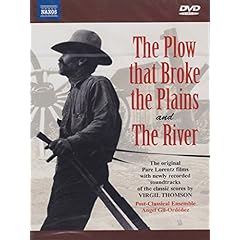Pare & Virgil
 For those of you who were insufficiently cheered by Florida’s decisive surge over the Ohio State football factory, here’s something that should help. Our friends at Naxos will release on January 31 a DVD of fellow Mountaineer Pare Lorentz’s landmark New Deal-era documentaries “The Plow that Broke the Plains” (1936) and “The River” (1938), featuring the first complete modern recordings of the seminal Virgil Thomson soundtracks by Washington, D.C.-based Post-Classical Ensemble under Angel Gil-Ordóñez, with narration by Floyd King.
For those of you who were insufficiently cheered by Florida’s decisive surge over the Ohio State football factory, here’s something that should help. Our friends at Naxos will release on January 31 a DVD of fellow Mountaineer Pare Lorentz’s landmark New Deal-era documentaries “The Plow that Broke the Plains” (1936) and “The River” (1938), featuring the first complete modern recordings of the seminal Virgil Thomson soundtracks by Washington, D.C.-based Post-Classical Ensemble under Angel Gil-Ordóñez, with narration by Floyd King.
“The Plow that Broke the Plains,” which examines the causes of the Dust Bowl drought and was made for $20,000, was the first film produced by the United States Government for commercial release. Despite being rejected by the film distribution system as New Deal propaganda, the documentary reached people in over 3,000 theaters. “The River,” which addressed flood control on the Mississippi River, won Best Documentary honors at the Venice Film Festival and received a Pulitzer Prize nomination for its script. It is probably unfair to call Lorentz Roosevelt’s Leni Riefenstahl but his films demonstrated the power of documentary to influence opinion.
Virgil Thomson’s soundtracks to both movies rank among the composer’s greatest work and also set the trend in the 1930s and 1940s for a new style of film music. A young Aaron Copland found the scores to be “fresher, more simple, and more personal” than most Hollywood soundtracks, “a lesson in how to treat Americana.”
Hey, somebody start some trouble over on the Composers Forum page.
I just relized I transposed the number in Virgil’s birth year–it was 1896, of course.
No to quibble too much, but Virgil was born in 1986, Copland in 1900. In 1936, and 38, the “young” Aaron Copland would have been 36 and 38 to Virgil’s 40 and 42. Incidentally, Copland’s earlier film music, for The City, followed in the same year by Of Mice and Men, dates from 1939. Another example which Virgil liked to point to of his getting there before Copland did (other examples were ballet and using folk material). But even if Copland was following in Virgil’s footsteps, he was doing so as a contemporary.
I wondered how long it would take for someone to pick up on that one.
The University of Florida is not a football factory?